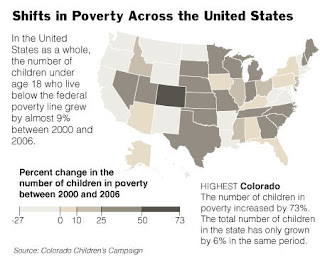Monday, June 30, 2008
Friday, June 27, 2008
Third World America?
From the LA Times:
Despite plummeting mortality rates for most infectious diseases over the last century, a group of largely overlooked bacterial, viral and parasitic infections is still plaguing the nation's poor, according to a report released this week.
Many of the diseases are typically associated with tropical developing countries but are surprisingly common in poor regions of the United States, according to the analysis, published in the Public Library of Science journal PLoS Neglected Tropical Diseases.
On its list of 24 "neglected infections of poverty" are schistosomiasis, a parasitic infection common in Africa; brucellosis, a bacterial infection from unsanitary dairy products; and dengue fever, a viral infection common in tropical Asia and South America.
Many of the diseases have become significant public health problems in the United States. In the Los Angeles area, a pork tapeworm infection called cysticercosis which spreads in crowded, unsanitary conditions, accounts for 10% of seizures resulting in emergency room visits, according to the report. Worm cysts in the brain cause the seizures and can lead to permanent epilepsy.
The 24 diseases afflict at least 300,000 Americans, and possibly millions, according to study author Dr. Peter Hotez, chairman of George Washington University's department of microbiology, immunology and tropical disease.
"These are right now below everybody's radar," Hotez said.
Wednesday, June 11, 2008
Growth in Child Poverty

Colorado takes the lead.
The most pronounced rates of child poverty were found in urban centers like Denver and in southern rural areas like Alamosa and Costilla Counties.
Minority children were particularly affected. The number of the state’s American Indian children living in poverty increased by 473 percent, the report said, and the number of impoverished black children grew by 116 percent. In contrast, the number of impoverished white children grew by 57 percent, and for Asian children, it declined by 10 percent.
At a news conference on Tuesday, Gov. Bill Ritter Jr. called the statistics “awful” and said that “they clearly demonstrate that we have a responsibility to people who live on the margins.”
“It’s intolerable that 180,000 children are living in poverty in this state,” said Mr. Ritter, a Democrat who took office last year.
In a supplemental document, the Colorado Children’s Campaign said the state spent less per capita on its residents than its neighbors to the north and south, Wyoming and New Mexico. Those states experienced a decrease in child poverty during the same six years as the study.
Colorado ranks 44th in per capita spending, according to the Colorado Fiscal Policy Institute, a research and advocacy group that focuses on tax and budget issues.
“This report and this finding validate a lot of what we largely know, in that Colorado continues to lag behind in key areas of public investment,” an institute spokesman, Scott Downes, said. “That prevents us from creating the kind of future that we want for our communities, our children and generations to come.”
Mr. Downes attributed the situation in part to a “knot of fiscal restraints” like a 1992 constitutional amendment, the Tax Payer’s Bill of Rights, that was intended to restrain state spending.
Colorado remained slightly below the national rate of child poverty of about 18 percent. “But the concern is the rate at which we’re growing,” Ms. Ferland said.
The rest is here.
Tuesday, June 10, 2008
Well, This isn't Good
Although perhaps not surprising:
How Many Are Underinsured? Trends Among
U.S. Adults, 2003 And 2007
Growing numbers of adults with insurance find that they are not
adequately protected from the rising cost of health care.
by Cathy Schoen, Sara R. Collins, Jennifer L. Kriss, and Michelle M. Doty
ABSTRACT: With health insurance moving toward greater patient cost sharing, this study finds a sharp increase in the number of underinsured people. Based on indicators of cost exposure relative to income, as of 2007 an estimated twenty-five million insured people ages 19–64 were underinsured—a 60 percent increase since 2003. The rate of increase was steepest among those with incomes above 200 percent of poverty, where underinsurance rates nearly tripled. In total, 42 percent of U.S. adults were underinsured or uninsured. The underinsured report high levels of access problems and financial stress. The findings underscore the need for policy attention to benefit design, to assure care and affordability.
Full article here
Monday, June 09, 2008
Perhaps of Interest:New Research
Center Voices Presents Findings from the Hunter College Poll
of Lesbians, Gays and Bisexuals:
New Discoveries about Identity, Political Attitudes,
and Civic Engagement
presented by
Patrick J. Egan, New York University
Murray S. Edelman, Rutgers University
Kenneth Sherrill, Hunter College‐CUNY
What do lesbians, gays and bisexuals (LGBs) think and believe about
politics and public affairs? What are their priorities for the lesbian,
gay, bisexual, and trangender movement? And how distinct are their
political values from those of Americans as a whole? Egan, Edelman
and Sherrill will address these questions in their discussion of the
path breaking study of the political attitudes, beliefs, and behaviors of
LGB Americans they conducted in November 2007.
The complete study may be found here:
http://www.nyu.edu/public.affairs/pdf/hunter_college_poll_report_complete.pdf
Date and Time: Wednesday, June 18 2008, 7:00pm
Location: Lesbian, Gay, Bisexual and Transgender Community Center
208 W. 13th Street, NYC
Admission is free and open to the public
for more information: email patrick.egan@nyu.edu
The presenters acknowledge the Human Rights Campaign Foundation for its
generous financial support of this study through a grant to Hunter College. The
investigators are solely responsible for the design and analysis of the study and the
work in no way reflects the views of the study’s sponsors.
Tuesday, June 03, 2008
Subscribe to:
Posts (Atom)
